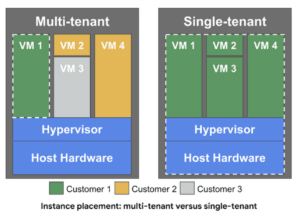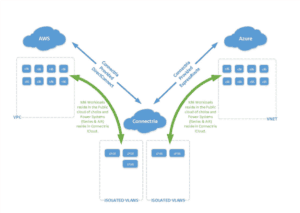Is the Public Cloud Really Public Anymore?
Connectria
Author
Date
May 30, 2019

When Amazon and Microsoft first started getting into the Infrastructure as a Service (IaaS) business with their public cloud offerings, many were skeptical. The performance was a very real issue in those first public cloud deployments. Internet congestion could be unpredictable, leading to latency issues, and shared infrastructure often led to “noisy neighbor” issues.
A noisy neighbor, in the language of cloud computing, is a co-tenant in your shared cloud infrastructure with unpredictable bandwidth requirements. For example, if you’re sharing resources with a large retailer, you may not see any bandwidth issues throughout the year. But if their business skyrockets during the holiday shopping season, it can affect your lag times, whether your cloud resource needs have changed or not.
2 Ways Public Clouds Can Address Private Cloud Needs
Innovators that they are, hyperscalers like AWS, Azure, and GCP (Google) recognized the challenge. All three leading providers of “public cloud” IaaS offer solutions to address public internet congestion and noisy neighbors. There are multiple definitions of the term hyperscaler. The most common refers to cloud providers that offer capacity far-exceeding that of their smaller competitors. It’s pointless to provide a number since more is being added every day, but GCP, Azure, and AWS all maintain millions of servers each.
1 Dedicated resources
As of Summer 2018, GCP joined AWS and Azure in offering dedicated host resources. These are physical servers which are single-tenant, i.e., reserved for your use alone. Think of it like renting a small apartment building with three apartments. You’re paying rent for the entire building, whether you decide to live in more than one apartment or not.
When it comes to living arrangements, this may or may not be a good use of funds. In the cloud computing world, it’s a great solution for workloads that have non-negotiable performance and security requirements. In both cases (apartment and servers), you won’t have to worry about noisy neighbors. (Or nosy neighbors either!)
GCP has the clearest, easiest-to-digest illustration of dedicated host resources. Keep in mind that the offerings from Azure and AWS are conceptually similar.

Source: Introducing sole-tenant nodes for Google Compute Engine – When Sharing Isn’t an Option
Private connections
Now that we’ve handled the noisy neighbor issue, let’s turn to the problem presented by the public internet. Azure, AWS, and GCP all offer direct connections to their host servers, which bypass the public internet. Not only does this address the challenge of traffic congestion, but it also mitigates the inherent security risks of data in transit.
Earlier this year, we packaged a solution offering for our IBM customers called the Managed IBM Cloud with AWS and Azure that illustrates the direct connection concept. In the graphic below, we show some workloads in a private hosted cloud on IBM infrastructure in one of our data centers with direct connections to both AWS and Azure.

Caution: It May Not Be as Simple as It Sounds
Of course, we’ve made everything sound slightly more simple than it often is. Though AWS, Azure, and GCP all offer dedicated host resources and direct connections, there are important differences between the offerings. Before choosing a public cloud, you should explore these differences carefully and/or get input from a Managed Cloud Provider that understands your unique requirements and the platforms.
There’s also the matter of setting these resources up to meet your performance, security, and compliance needs. When your IT staff is working in an unfamiliar environment, it’s easy to leave a resource exposed. They may also not understand which features you need and how best to deploy them, resulting in lower performance and higher monthly expenses.
Contact Connectria for more information. If you’d like to talk with someone about the public cloud options that may be right for you and how you can meet your security and performance needs, one of our cloud advisors would be happy to help.
Keep Reading
Prepare for the future
Tell us about your current environment and we’ll show you the best path forward.
Fast track your project. Give us a call.






